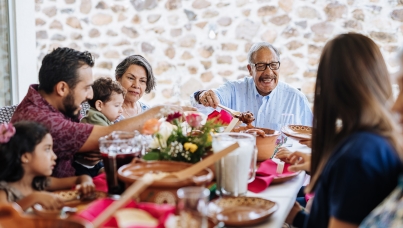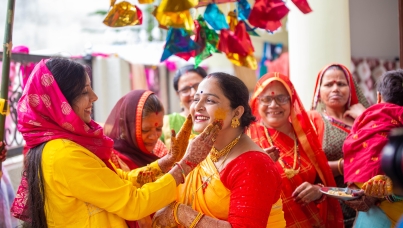

Urban India Abuzz with Festival Shopping Excitement
As the country enters the vibrant festive season, the latest Ipsos IndiaBus Festival Shopping Survey 2025 reveals a wave of consumer enthusiasm sweeping across urban India. Citizens are embracing the festive spirit with great fervour, driven by attractive discounts and offers from brands and local retailers. The survey highlights that a vast majority of urban consumers are excited about shopping this festive season, with nine out of ten respondents expressing enthusiasm. Among them, 60% reported being highly or moderately excited, while another 30% were slightly excited — signalling much cheer for the festival season, with Karwa Chauth, Dhanteras, Diwali and Bhaiduj coming up. GST 2.0 rate cuts and savings are adding to the festive cheer.
In-store/ omnichannel appeals to shoppers
The study provides a deeper understanding of how India shops during the festive period. While omnichannel retail continues to gain traction, in-store shopping remains the dominant choice for most shoppers. Over half of those surveyed prefer to shop in physical stores, while around one-fourth use a combination of in-store and online platforms. Online-only shopping continues to attract a smaller, yet significant, proportion of consumers. Shopping preferences also differ across demographic groups. Consumers aged 45 and above, as well as those in SEC B and C segments, overwhelmingly prefer in-store shopping. In contrast, SEC A consumers show a more even distribution across shopping formats, with a sizeable number opting for online or mixed approaches. Education also plays a role in shaping shopping habits. Consumers with lower education levels are more likely to shop in-store, whereas those with higher education demonstrate a greater inclination toward online and hybrid shopping models.
Quality biggest consideration for shoppers
The survey also explored the key factors influencing shopping decisions. Quality emerged as the most critical factor for consumers, cited by 70% of respondents. Price and discounts were close behind, each influencing 62% of shoppers. Brand reputation, while less prominent overall, still played a role for 33% of the participants. Notably, consumers from SEC A were more discerning, placing greater emphasis on quality, pricing, discounts, and brand reputation. In contrast, consumers in the East zone showed a different pattern. For them, discounts had a stronger influence than quality or brand image, with price sensitivity also playing a considerable role in their purchasing decisions.
Online Shopping Events show stickiness
Indian consumers continue to show high engagement with online festive sales events. The Amazon Great Indian Festival emerged as the top choice for festive shoppers, followed closely by Flipkart’s Big Billion Days. Myntra’s Big Shopping Festival and Meesho’s Maha Indian Shopping League were also popular, while other niche sales events like Snapdeal’s Unbox Diwali Sale, Nykaa’s Grand Festive Sale and Ajio’s Navratri Sale garnered interest among specific segments. The preference clearly leans towards larger e-commerce platforms offering a wider variety of products, indicating consumer appetite for value and assortment during the festival period.
The survey also captured what citizens plan to buy this season. Apparel tops the shopping list, followed by sweets and snacks, puja items, dry fruits and chocolates, home décor, firecrackers, jewellery and consumer electronics. Interestingly, more men than women plan to spend on apparel. Traditional categories like sweets, puja items and dry fruits continue to dominate, reinforcing longstanding cultural shopping practices associated with Diwali and other festivals.
There were marked regional differences in shopping capacity and enthusiasm. Consumers in metro cities are planning to shop across a broader range of categories and spend more overall. For instance, the majority of metro respondents indicated plans to buy apparel, sweets, puja items, dry fruits, décor and jewellery. On the other hand, consumers in the East zone showed a more conservative shopping approach, focusing primarily on puja items, sweets and basic festive necessities, with significantly lower intention to purchase items like jewellery and décor.
Commenting on the findings, Archana Gupta, Executive Director, Shopper Insights at Ipsos India, said, “The festival season with a plethora of festivals like Navratri, Karwa Chauth, Dhanteras, Diwali, Bhaiduj etc, is unleashing joy and festive fervour among citizens. Both offline and online marketplaces are resplendent with attractive offers, and families, akin to making hay while the sun shines, are in the mindset to shop and splurge. The survey rightly highlights the key elements of festival shopping. Net-net, it’s a win-win for all stakeholders – shoppers and shopkeepers alike. GST 2.0 tax rate cuts on non- essentials will lead to more savings for the consumers and price reduction will endear consumers more to loosen their purse strings this festival season.”
The Ipsos IndiaBus Festival Shopping Survey 2025 paints a detailed and nuanced picture of festive consumer behaviour in urban India. It offers valuable insights for retailers, brands and marketers looking to tap into India’s biggest retail moment of the year. With consumers ready to spend and the market buzzing with offers, the festive season of 2025 is shaping up to be one of the most promising yet for Indian retail.
Ipsos IndiaBus is a monthly pan India omnibus (which also runs multiple client surveys), that uses a structured questionnaire and is conducted by Ipsos India on diverse topics among 2200+ respondents from SEC A, B and C households, covering adults of both genders from all four zones in the country. The survey is conducted in metros, Tier 1, Tier 2 and Tier 3 towns, providing a more robust and representative view of urban Indians. The respondents were polled face to face and online. We have city-level quota for each demographic segments that ensure the waves are identical and no additional sampling error. The data is weighted by demographics and city-class population to arrive at national average.



